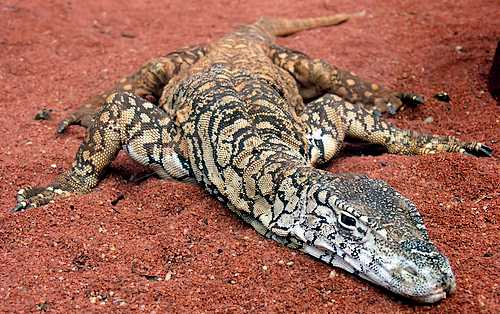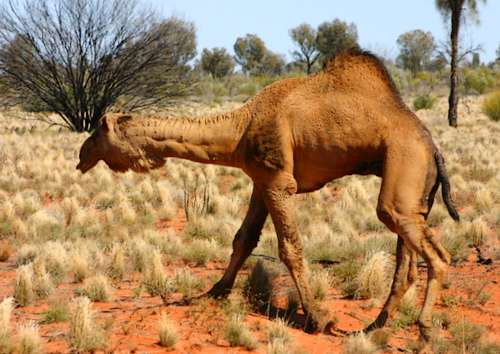 Australian Desert Perentie Animals
Australian Desert Perentie AnimalsPerenties are amongst the top predators in the Australian deserts. Not that the Perentie would need them. Those burrows are huge and often have many escape tunnels. The Perentie, a two meter monitor lizard that lives in the Australian deserts, uses the same strategy: it shelters in underground burrows.
 Australian Desert Camels Animals
Australian Desert Camels AnimalsInterestingly the working camels bred in Australia turned out to be of much higher quality than the imported camels. The first of several Australian camel studs was established in 1866 in South Australia, and the studs went on to operate for fifty more years. On top of that Australians also started breeding their own camels. Apparently there were only about 20 two humped camels (bactrian camels of the species Camelus bactrianus) imported during that time. The camels came to Australia mostly from India and Palestine, and nearly all of them were dromedaries (the one humped variety Camelus dromedarius). And in the next fifty years an estimated 10 000 to 12 000 camels made their way to Australia! 24 more camels arrived in Australia in 1860 to be part of the Bourke and Wills expedition. (This was a somewhat unlucky camel, as it accidentally caused its owners death and was subsequently shot...) But this first camel was soon followed by others. The very first camel to ever set foot on the red Australian soil arrived in 1840 and came from the Canary Islands.
 Australian Desert Bilby Animals Photos
Australian Desert Bilby Animals PhotosJust like the little fellow in the picture above. They get enough moisture from their food: seeds, bulbs, fungi, spiders and insects, which they find by scratching and digging. They are so efficient in conserving water that they don't need to drink. Bilbies dig burrows that are one to two metres below ground and moister and up to ten degrees cooler than the surface. Like most desert animals the bilby hides during the day and forages at night to avoid heat and dehydration. Only small, fragmented populations survive in parts of the Tanami, the Gibson and the Great Sandy deserts. Today its range is a lot more restricted (due to the usual environmental problems that we humans cause). The pretty and delicate bilby once lived across most of the Australian inland deserts.
 Australian Desert Red Kangaroo Animals
Australian Desert Red Kangaroo AnimalsIt evolved because Red Kangaroos need to cover huge distances to find enough food in the sparsely vegetated Australian desert. Hopping is a fast and very energy-efficient way to travel. And their adaptation to their environment is the one aspect they are so famous for: the hopping. The "big reds" are the species that inhabits the driest parts of Australia, the central deserts. The Red Kangaroo, the largest marsupial in the world, is the most famous kangaroo species, but it is only one of many.
 Australian Desert Thorny Devil Animals
Australian Desert Thorny Devil AnimalsThey are very hard to find. If you are hoping to see one on your travels, good luck. Its distribution seems to be determined more by soil type (it likes sand and sandy loam) than by climate or anything else. The habitat of the thorny devil are the dry inland regions of Outback Australia and the south western coast. The thorny devil is one of the most unusual looking animals of the Australian desert, and its adaptation to its harsh environment is ingenious to say the least.

